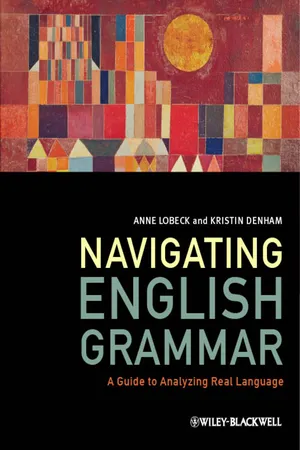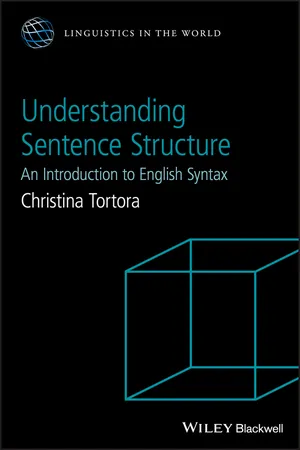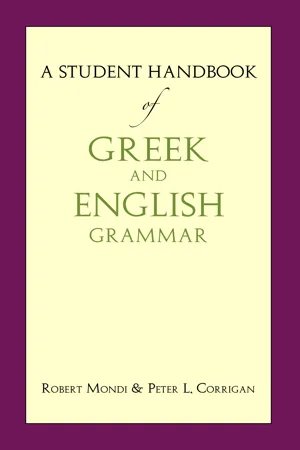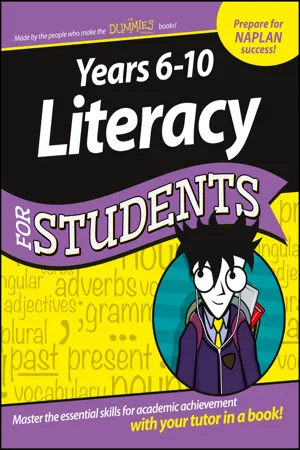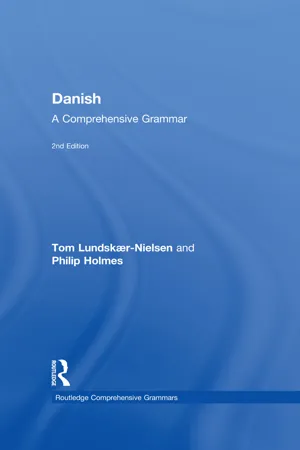Languages & Linguistics
Main Verbs
Main verbs are the central component of a sentence, expressing the action or state of being of the subject. They convey the main meaning of the sentence and can stand alone in a sentence. In English, main verbs can be modified by auxiliary verbs to indicate tense, aspect, mood, and voice.
Written by Perlego with AI-assistance
Related key terms
5 Key excerpts on "Main Verbs"
- eBook - ePub
Navigating English Grammar
A Guide to Analyzing Real Language
- Anne Lobeck, Kristin Denham(Authors)
- 2013(Publication Date)
- Wiley-Blackwell(Publisher)
forms of English Main Verbs. We’ll see that there is quite a bit of variation among these forms in current varieties of American English, and that the forms of many English Main Verbs have changed quite a bit over time (and continue to do so).Main VerbsWe can divide the (larger) category Verbs up in different ways. We can distinguish among auxiliary , or helping verbs, including have and be ; the class of modals , such as may , might , can , could , or will ; and the class of Main Verbs , including words such as eat , sleep , become , amuse , drive , or feel . Main Verbs have lexical meanings, and like the other lexical categories we’ve discussed so far, Noun and Adjective, the category Main Verb is an open class; we can add new members to it, and we do so all the time. We blog , text , and IM each other, we downsize and we outsource .Main Verbs can be pretty easy to spot; every clause must have a main verb, so we know, when there’s only one verb in a clause, that it must be a main verb!The zebra chased main verb a lion. Murray became main verb a surgeon. Shakespeare is main verb a famous author. We can define main verbs, then, as the required verbal element in a verb string. Another way to put this is to say that the main verb is the head of the verb phrase, or VP. That means that any time you have a verb phrase, you’ll have (at least) a main verb. (We have to modify this notion a bit later.) Some simple VPs are given below, each headed by a main verb.In these tree diagrams, chased , became , and is are all Main Verbs. Interestingly, is , a form of the verb be , is a main verb, but it’s functional rather than lexical. The verb be is an exception to the claim we made above that Main Verbs are a lexical category. We will discuss be more as we progress through this and the following chapters.Main Verb MorphologyIn this section we discuss the ways we build Main Verbs through derivational affixation, and how we create new Main Verbs using different word formation rules. We spend quite a bit of time discussing the inflectional morphology of Main Verbs because it is inflectional morphology that gives us the five different forms of the verb. - eBook - ePub
Understanding Sentence Structure
An Introduction to English Syntax
- Christina Tortora(Author)
- 2018(Publication Date)
- Wiley-Blackwell(Publisher)
8 Main Verbs and the Simple Tensesexpected outcomes for this chapter
- You’ll gain an in‐depth understanding of the concept of tense and verb forms.
- You’ll gain a more in‐depth understanding of what a main verb is in relation to an auxiliary verb.
- You’ll develop more confidence with the concepts from previous chapters (e.g., verbs and the verb phrase, agreement, infinitival, tensed/untensed, ambiguity, and variation).
- You’ll begin to gain expertise in understanding the English verb system, setting the stage for your understanding of Chapters 9 and 10 .
- You’ll become familiar with the following concepts and terms: main verb, auxiliary verb, modal auxiliary, present tense, tensed, untensed, past tense, preterite, simple tense, verb form, subject–verb agreement, infinitive, bare infinitive, verb paradigm, paradigm levelling, inflection.
8.1 overview: the “main verb” and its entourage
By now you’re used to the fact that each chapter of this book revisits some phrase we investigated in an earlier chapter, delving into that phrase more deeply. Here and in Chapters 9 and 10 , we’ll continue this habit with a further look at the more intricate patterns exhibited by verbs. Unsurprisingly, we’re going to see that the VP and the sentence allow for much more complexity than we’ve so far explored. This complexity reflects the fact that English speakers have highly structured and diverse means for expressing the times of events and physical / mental states . On top of this, much as we’ve already seen in other areas of the grammar, we’ll see that when it comes to verbs, there’s a lot of variation among and across English speakers regarding structural (and lexical!) possibilities for expressing the same thing.It might surprise you to see that in this chapter, I talk less about structure and more about the forms of words, and the kinds of meanings that these forms give to the sentence. This is because in order to understand the syntax of main and auxiliary verbs, it’s important to understand some basics about tense and verb forms . This unto itself involves some discussion (i) of the meanings of tenses, and (ii) of the kinds of morphological forms that Main Verbs can take. (See Term Box 3 in Chapter 10 for a discussion of the concept of morphology.) At a certain level, then, the discussion is outside of the realm of syntactic structure; we’ll thus have to wait until Chapter 10 - eBook - ePub
- Robert Mondi, Peter L. Corrigan(Authors)
- 2013(Publication Date)
- Hackett Publishing Company, Inc.(Publisher)
III. THE SYNTAX OF VERBS AND RELATED ELEMENTS11. VERBS
A verb is the word which expresses the acting, being, doing, etc., in a clause or sentence. Like nouns, a verb as a vocabulary item carries a semantic meaning, but it takes on a variety of different forms which indicate its precise syntactic role in the sentence or clause. Whereas a listing of all the forms of a noun is called its declension, for a verb this listing is called its conjugation , and to make such a list is to conjugate the verb. As was also true in the case of nouns, unfortunately not all verbs use the same set of endings. All verbs belong to one of two conjugations, called thematic (that is, relying on consistent vowel[s]) and athematic (relying on no consistent vowel).Remember, verbs can be action verbs, linking verbs, or auxiliary verbs; see §2.6. We saw that two things are needed to specify a particular noun form: case and number; for an adjective, with the addition of gender, three things are required. For verbs, the number is five:Person (3): 1st, 2nd, or 3rd Number (3): singular, dual (rare in Attic Greek), or plural Tense (7): present, future, imperfect, aorist, perfect, pluperfect, or future perfect. Voice (3): active, middle, or passive Mood (4): indicative, imperative, optative, or subjunctiveSo, for example, the phrase “3rd-person plural aorist active optative” will designate a unique verb form.English verbs have one of the simplest inflectional systems of any European language. For regular verbs, the only suffixes are -(e)s in the present and -(e)d - eBook - ePub
- (Author)
- 2015(Publication Date)
- For Dummies(Publisher)
subject) to tell you who performs the action of the verb.Verbs are at the core of a sentence, and you should start with the verb when you want to do anything to your sentence — including correct it. So, in this chapter we look at different types of verbs, how to find them and how they fit together with subjects.Verifying Verbs
Verbs come in various shapes and sizes — action and linking, auxiliary and main, regular and irregular, singular and plural. They can be present, past and future. The tense of a verb tells you when the action is happening. Making sure that you have the right verb in the right place is the key to understanding sentences. So in this section, we’re going to reacquaint you with the different types of verbs, show how they often hang out together in groups, and give you the lowdown on how to locate the verb in a sentence.Happening with action verbs
Action verbs are the real ‘doing words’. Something happens in a sentence with an action verb:Chris buys and then devours three pasties as a snack. (Buys and devours are action verbs.)Ed had answered the question even before it was asked. (Had answered and was asked are action verbs.)Don’t let the name action fool you. Some action verbs aren’t particularly energetic: think, sit, stay, have, sleep, dream and so on. Besides describing the perfect day off, these words are also action verbs.Being with linking verbs
Not all verbs are as busy as action verbs. Linking verbs are also called being verbs because they express states of being — what is, will be or was. (Not surprisingly, the verb used to express the state of being is often the verb to be.) You can think of a linking verb as an equals sign in the middle of your sentence. In the same way that an equals sign tells you that the parts on either side of it are the same value, the word is - eBook - ePub
- Tom Lundskaer-Nielsen, Philip Holmes(Authors)
- 2015(Publication Date)
- Routledge(Publisher)
reflexive verbs. This section will deal with these five categories.5.5.1.1
Main verbs appear either as the only verb in the clause, and then in a finite form, or as the last verb in a sequence of two or more verb forms in the verb phrase, in which case it is in a non-finite form (see 5.1.1). Main Verbs are usually richer in terms of semantic content (‘lexical verbs’), while auxiliary verbs tend to have a weak semantic content (‘functional verbs’) but showing tense, mood and/or aspect:Finite forms Han venter på sin kollega.He’s waiting for his colleague. Hun skrev et læserbrev.She wrote a letter to the editor. Hent mine briller!Fetch my glasses! When a verb which can function as an auxiliary verb is the only element of the verb phrase, it is the main verb in that clause:Non-finite forms De er rejst til Spanien.They’ve gone to Spain. Han burde have set cyklisten.He ought to have seen the cyclist. Hun vil lige kunne nå bussen.She will just be able to catch the bus. More than one main verb can occur in a clause when they are coordinated (see 10.1.4.2):Min nabo er meget venlig.My neighbour is very friendly. De har to børn.They have two children. Hun skal i skole om lidt.She is going to school shortly. Han står og ser på bøgerne.He stands looking at the books. Hun havde læst og syet i en time.She had read and sewed for an hour. 5.5.1.2
Auxiliary verbs, as the name suggests, largely have the function of ‘supporting’ the main verb. Verbs that can function as auxiliary verbs are: blive (be/become), have (have), være (be) and the modal verbs (see 5.4.2) plus some uses of få
Index pages curate the most relevant extracts from our library of academic textbooks. They’ve been created using an in-house natural language model (NLM), each adding context and meaning to key research topics.
